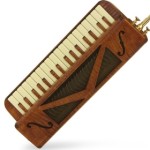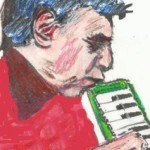Gold Standard for Blues Melodica
Tagged: Blues melodica
- This topic has 11 replies, 7 voices, and was last updated 7 years, 8 months ago by
 jazzman1945.
jazzman1945.
-
AuthorPosts
-
March 2, 2015 at 2:58 pm #4246
 LowboyParticipant
LowboyParticipantHi,
For you folks who are interested in playing the blues on the melodica, I found a recording of an acoustic duo (acoustic guitar and a harp player) that you could call the gold standard of blues harp playing. [Of course there are thousands of recordings this good, but this one has to be near the top in terms of expressiveness, at least in my opinion.]
Can any instrument sound as expressive as a harp in the hands of a bluesman? Wow, this player (Billy Branch) just graps you with his “feelings” and does not let you go. Listen to the recording below. You will not be wasting your time. True art is there.
The expressiveness of this playing is what I am trying to achieve with the melodica. I continue to have breakthroughs every week, even after more than a year of experimentation. However, I still have a long way to go to come close this extraordinary recording . . . but I am getting there. This is a recording I am going to use to continue to develop my “keyboard harmonica” technique.
Listening to this using good audio equipment or headphones is recommended to get the full impact of the tone variations and Billy Branch’s skill.
https://www.youtube.com/watch?v=5kh71EYES7M
Lowboy
March 8, 2015 at 8:46 pm #4351 QuetscherParticipant
QuetscherParticipantHi Lowboy,
thanks for that inspiring music you posted; it made me happy and sad at the same time – happy because of that expressiveness of the harp, and sad because I had the feeling that we melodica players will never achieve that richness of sound and expression: neither can we produce WahWahs that way nor can we do bendings like that (especially chords!) nor can we modulate the sound by forming certain vowels in our oral cavity and then playing.
But then I thought of all our efforts to push forward the development of melodica playing, and I thought of things we can do that harp players will never be able to do. Thanks to the keyboard we can play EACH melody and especially EACH chord exactly the way we want to without compromise (meaning 1.we can play chords with each extension we want and 2.we can play a chord in close harmony or in open position); we can play trumpet style and flute style; we can play with both hands which enables drones; we can play with a much wider dynamic range; we will find ways to produce proper WahWahs (think of your belly WahWah!) and so on… – and all this made me feel happy again because I suddenly knew that this is what melodicaworld.com is existing for, to give us a platform which brings us forward with melodica playing…
This may sound sugary, but for me it’s true – I’ve learned a lot from you guys and still will learn a lot for (hopefully!) a long time.March 10, 2015 at 5:01 pm #4358 LowboyParticipant
LowboyParticipantAmen Brother.
Lowboy
April 13, 2015 at 3:33 am #4643 Shannon MParticipant
Shannon MParticipantit appears that the video account has been closed. Anyone know of another source for this recording?
May 9, 2015 at 8:40 am #4993Mark O’Trumea
ParticipantPerhaps it is up to us here, to determine what level of emotion the _melodica_ can reach. Rather than comparing it to the harmonica?
May 9, 2015 at 11:00 am #4994 LowboyParticipant
LowboyParticipantHi Mark and Others,
Sorry if I over do the harmonica comparisons.
I think it is only natural to look at other instruments and apply what we learn to our own instrument; especially in my case, where I am trying to emulate the blues harp for playing the blues.
I purchased a Hohner Marine Band blues harp a few days ago just to understand the capability of free reed instruments better. I have learned a lot from studying the harmonica and I have only owned it about three or four days. I played several years with a great harp player, but never really looked at his instruments.
Unamplified, a Hohner Marine Band harp sounds much warmer and has considerable less volume than a melodica. This was a surprise to me after listening to blues players for a million years. The instrument is so simple. A block of wood with holes, two reed plates, and two metal covers. The darn thing is so small! It’s about the length of your index finger. How do players get such a huge sound from this little instrument! The reeds are about 1/4 inch from your mouth. When you look at it from the back, you see the reeds are just exposed to the air. Then are just right there hanging out, yet the sound is very smooth when played unamplified.
I learned several other things. I learned what notes are played when a harp player plays chords so I can kind of imitate that. I learned, just like the melodica, how hard it might be to make great music with a harp. I can see it would take weeks and weeks of practice just to make a good sounding note. Clearly with the harp, as with the melodica, it is the player and the application of hundreds of techniques (and soul of course) that make the instrument talk.
While there is one website for the melodica (the venerable Melocia World), there are scores and scores of really great websites by professional harp players (blues and otherwise) filled with so much information it is hard to believe. I have gathered many great ideas about playing and technique from these websites and some of the instructional videos on these websites.
So with that said, I will try to focus more on the melodica with my posts except for one more post that I will publish in a few minutes.
Lowboy
May 9, 2015 at 3:23 pm #4999 DarenKeymaster
DarenKeymasterHey Lowboy, please do continue with the harmonica comparisons! Any angle for improving melodica technique is valuable. And I’m sure that many of us here respect your passion for the harmonica, and your dedication to finding ways to emulate its expression and performance capabilities. I’m very interested in your journey.
May 9, 2015 at 9:15 pm #5000 Alan BrintonParticipant
Alan BrintonParticipantThe recording, as I recall, is from the Kenny Neal album Double Take, which is on Rhapsody and also can be downloaded in MP3 from Amazon.com. And there’s this YouTube link, which I think has a different cut, but one that illustrates Lowboy’s point.
When I listen to this clip I can’t help but thinking “Wow! Can somebody do that with a melodica?” The melodica has its own unique set of expressive possibilities, I’m thinking, but trying to get a blues harmonica sound is one way of exploring those possibilities. Toots Thielemans next, somebody?
May 10, 2015 at 10:28 am #5002 LowboyParticipant
LowboyParticipantNot to muddy the waters but I posted the wrong take, which Alan reposted. Below is a take that is actually much smoother in both tone of the harmonica and the playing. This is a much better example.
Lowboy
May 10, 2015 at 10:57 am #5003 LowboyParticipant
LowboyParticipantSo while I have developed many of these harp-based expressive techniques on HM-26/27/32, the real trick is to execute them in a refined way, integrate them together, and execute them in real time at the speed at which songs move.
I figure it will take about another year of practice to get really proficient at it, particularly executing the techniques newest to me. I am getting there and will post a recording as soon as I can.
Quick note: There is lots of microphone positioning involved, which makes playing very dynamic. The mic comes in at chest level from the 9:00 o’clock position. Sometimes the mic must be at the side of the melodica, which is pressed against my chest or being flung around, sometimes I squish the mic between the back of the melodica and my chest (big foam windscreen on mic), and sometimes the top of the melodica is tipped out from the chest and the mic must be near the space between my neck and the melodica. Lots of movement. I have to use a short tube whether I like it or not to be able to move the melodica around while keep my head up straight. I am still figuring out if/when/how to move the mic quickly to different positions. Maybe I must move more to accommodate the mic. Not sure yet.
Lowboy
May 11, 2015 at 4:56 am #5007 QuetscherParticipant
QuetscherParticipantFor each one who can’t watch the videos that Lowboy and Alan posted here’s the audio file:
August 13, 2016 at 10:00 am #7489 jazzman1945Participant
jazzman1945ParticipantThe first property of blues sound – its instability, constant modulation in pitch. This can be achieved in several ways (without mouthpiece) :
https://yadi.sk/d/nSSZRlALuBVCL” target=”_blank”>Blues touchNarrowing and widening the gap between lips -from the beginning of record
The tip of tongue is inserted into the tap-hole and retracts back -after the first pause
Active soundless articulating the mouth, combined with a slight touch the keys to a minimum depth-after the second pause
For comparison, I blow the usual straight way , by pressing the keys like the piano; and even with a little vibrato, then I’m going back to the active articulation. -
AuthorPosts
- You must be logged in to reply to this topic.
